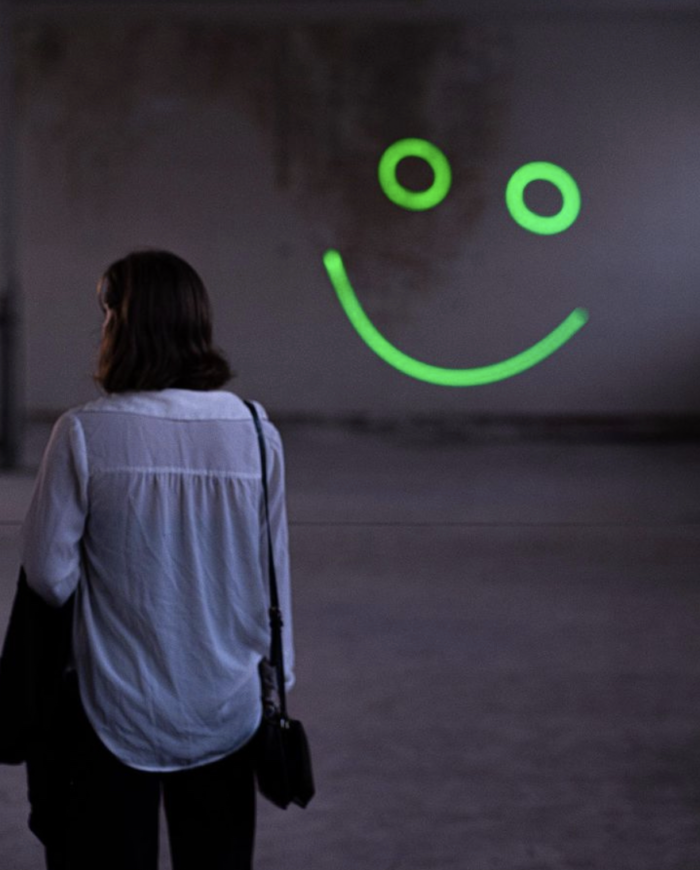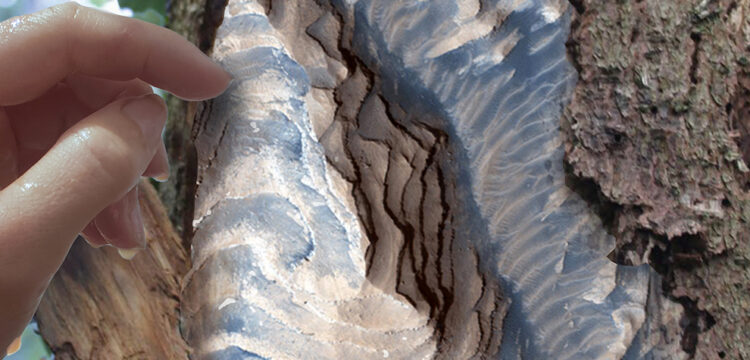A Laugh Will Bury You All
Practices of Resistance in Davide Sgambaro’s Work
Davide Sgambaro’s project for Manifattura Tabacchi and NAM – Not a Museum materializes ambitions and uncertainties peculiar to a generation (perhaps an era) that is the product of a system in crisis, based on efficiency and competition. However, the artist’s work seems to suggest an alternative to this tragic condition: a rebellion that begins with laughter.
It would be enough to look at the wall. It would only take observing its irregularities to detect the crack that tries to conceal itself behind the smile. The green light strikes the wall: though without intermittence, the luminous reference seems to recall that glow, of the same color, to which Jay Gatsby stubbornly clung. A mirage of an orgiastic [1] future and a mirror of an era now in decline, not so dissimilar to the contemporary.

In Davide Sgambaro’s large smiley face I perceive the reverberation of that same light, transfigured by time and having become more effective because of its ability to spread and multiply the number of unfulfilled expectations. The laser that projects it, in a hypnotic and manic manner, always traces the same trajectory to reproduce a symbol that stands out indiscriminately on T-shirts and ecstasy pills, showing the absolute semantic flattening common to every capitalist manifestation. The smile, rather than embodying an empathic reaction, appears unnatural and helpless, probably chemically induced by drugs or prescription pills, and in its complete artificiality also seems to stand as a demonstration of a state of stillness, a kind of ataraxia or ironic detachment motivated by the awareness of an absolute lack of alternatives. If in that sense Fenomeno (Smiley) appears as a symptom of that reflexive impotence that Mark Fisher attributed to his students and described as a state of torpor dictated by the absence of perspectives, on the contrary its sardonic appearance seems to configure it as an instrument of subversion.

Installation, green laser, laser controller, computer, environmental dimensions.
Installation view Manifattura Tabacchi, Firenze.
Courtesy the artist and NAM – Not A Museum (Florence). Photo Alessia Messina
Rather than Fisher, I think I would then recall the words printed on a poster made in 1977 by the Soccorso Rosso Militante, set to accompany a photo depicting a joyous anarcho-syndicalist who had just been arrested: “A Laugh Will Bury You All.” I do think that Sgambaro’s work is marked by the same attitude of challenge and resistance, and a playful tragicness that aims to strike at the symbols of a society founded on leisure, profit, and competition. Each object selected by the artist seems to disprove the very system that produced it, certainly not through a detournemént, which would imply the reversal of meaning, but through the simple, and for this reason effective, presentation of what those objects are called to do: entertain. This is the case with the already mentioned Fenomeno (Smiley), as well as with the firecrackers from the series I push a finger into my eyes (kiss, kick, kiss), residues of a solipsistic explosion, of a burnout suffocated within the confines of a showcase.

Or with the performances entitled Too much and not the mood, in which the vocal distortion produced by the inhalation of helium and the throwing of popcorn become instruments of awareness, denunciation, and resistance against the pressure generated by an art system increasingly driven by the mechanisms of market and productivity. The solution, or at least the response to a condition that is perceived as unbearable, thus consists in the lucid representation of the paroxysm that is embedded in the phenomenon.

By reflecting its image, the artist reveals its absurdity and that affabulatory and seductive character that compels us to participate and desire.
In other words, we keep chasing the green light, a future of achievements and success. Whether it’s unreachable doesn’t matter: “tomorrow we will run faster, stretch out our arms farther… and one fine morning…” [2]
[1] Francis Scott Fitzgerald, Il grande Gatsby, Mondadori, 2012, p. 145.
[2] Ibid.



